(CAVEAT: I have not been a massage therapist for very long. This is literally just me spitballin’–at the same time, this was a really good exercise for me! I like using the assessment part of my brain.)
It’s been tossed around in fandom that Bucky’s muscles have to be pretty f-ed up from having a cybernetic, metal arm grafted onto one side of his body. From the perspective of a massage therapist, that’s 100% accurate–but the issues don’t stop there. At the very least he’s got functional scoliosis and massive compensatory muscle strain, enough adhesions to make Jesus weep, and tons of somato-emotional holding points.
First, a couple notes: I’m including adhesions on the list because I don’t think the serum would prevent these from happening, at least not entirely. Adhesions happen when connective tissue–the single most prevalent tissue in the human body that wraps everything from muscles to bones to organs to nerves–becomes damaged. Connective tissue (CT) consists of water, cells, and most importantly protein fibers; just like the fibers of yarn, they can become tangled in surrounding structures. That’s really what they’re supposed to do, in order to anchor things and quite literally hold us together. Unfortunately, damage resulting from injury, surgery, infection, inflammation, overuse, or old age can cause the fibers to tangle in the wrong ways. Thus, adhesions form (scar tissue being the most common form). Now, I don’t think the serum would stop these from happening, as they’re literally part of the body attempting to repair itself. Perhaps Erskine’s version would, but I don’t see HYDRA giving much of a damn how their super-soldier healed so long as he could still function. Any adhesions that got bad enough to impede his movements, they could simply fix with surgery or the HYDRA equivalent of the Graston technique.
What’s the Graston technique, you wonder?
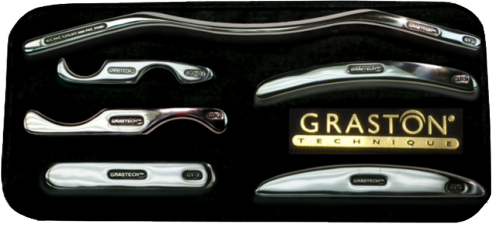
I’m so glad you asked! It’s the process of taking the above tools and scraping the connective tissue fibers into lying the way they’re supposed to, as well as breaking up adhesions. It is…okay, I’ve never had it done personally but I am given to understand that it is incredibly painful.
(Now think about the fact that Bucky associates that with physical therapy and people who say they’re going to treat his muscles.)
Second, obviously the arm itself is very heavy. In multiple comic book sources, Bucky Barnes is listed as being 5'9" (175cm) and 260lbs (118kg). Sebastian Stan is slightly taller at 5'11" (180 cm), but even then a 5'11" man with a medium frame is about 154-166lbs (70-74kg). From that we can extrapolate that the arm is at least 50lbs (23kg).
Whatever the exact measurements, the arm is heavy enough that I would bet normal bones and muscles couldn’t support it. Judging from where skin meets metal in the picture below, I’d say that the bones of Bucky’s entire shoulder girdle have had the metal arm grafted onto them. Note how the metal curves inward to follow the collarbone? Yeah, either it’s attached to the bone or the bone had been replaced. I wish we had a shot from the back so I could see the metal’s interactions with the shoulderblade but I’m going to take a wild guess and say that the metal extends at least to the spine of the scapula–that ridge of bone you can feel when you put a hand over your shoulder–and possibly further down onto the fossa.
I’ve also seen it banded about in fandom that the muscles would have been replaced as well–but one, there is a shitton of muscles attached to the arm, and I don’t think even a super-soldier could survive having them all replaced, and two, the whole point of serum-strong muscles is that they can be stronger than regular human muscles. (Also, if you’re using this post as reference for healing massage fics, there wouldn’t be much point in Steve rubbing synthetic muscles.)
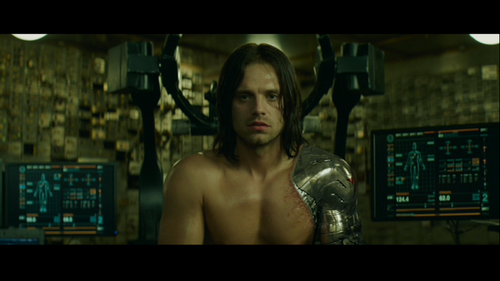
From the brief image of a bone saw cutting off the arm, seen below, I would guess that part of the upper humerus (the bone of the upper arm) is still in place and that, too, has had metal grafted onto it. I know a lot of writers (myself included) have grabbed onto the idea of a metal ball-and-socket joint, but from a massage therapist POV, I find that less plausible (as plausible as a metal-armed brainwashed assassin can ever be). I find it far more plausible, from a ‘not-having-to-replace-ALL-the-muscles’ POV, that Zola and the other scientists anchored the metal arm on the stub of humerus that Bucky had left, pumped him full of serum, and expected his body to be able to carry that weight.
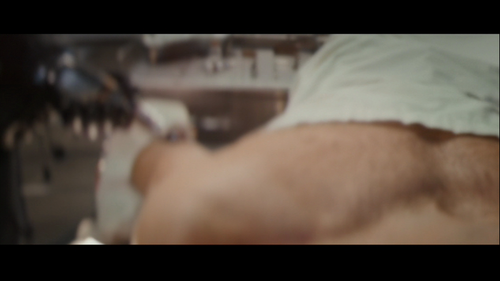
Obviously the muscles of the arm itself and some of the shoulder are gone and replaced by the metal arm: deltoid, biceps brachii, triceps, all of the forearm and hand. I would also guess, again without seeing the back, that all of the rotator cuff muscles and tendons are gone.
However, I think that for the most part, Bucky still has his actual muscles and his actual bones, with some metal grafted onto them.
Anyway. On to the analysis. Here are the physical issues that I think Bucky would have.
1. Functional scoliosis of the thoracic vertebrae, with accompanying compensatory patterns. Pick up something really heavy using only one arm–or really, don’t. Please.
Having 50 extra pounds on one side would do horrible, horrible things to your body. For one thing it would automatically create a curve in your spine. In Bucky’s case, that’d be a sharp curve to the left in the thoracic (ribcage) vertebrae. Obviously he isn’t walking around with his left shoulder sharply dropped; that’s where compensatory structures come into play. “Functional scoliotic cases are frequently accompanied by other signs of faulty and relaxed posture, such as rounded shoulders, prominent abdomen, and flat feet.” (Massage and Bodywork Magazine, Dalton, 2003, pg 69.) Or, if you need a visual explanation:
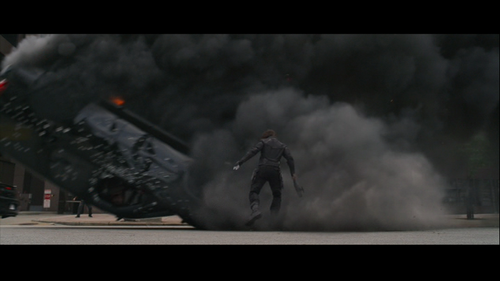
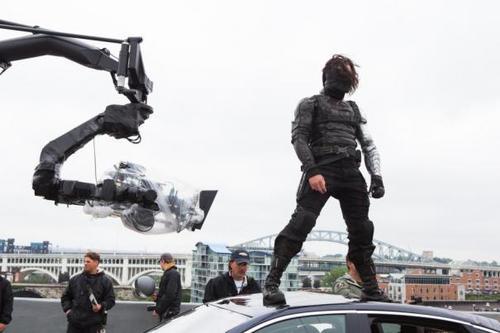
A bit of brilliant non-acting acting on the part of Sebastian Stan. That is exactly how someone dealing with sharp lateral curvature of the spine would stand in order to offset that weight. Try picking up an object in one arm and then swinging it around to the front. It’s a lot easier to hold, isn’t it? That’s because the weight is closer to your midline instead of wayyy out to the side.
Unfortunately that creates a whole host of compensatory problems. Slumped shoulders equals tight pectorals, tight front of the the neck, decreased functionality of the lungs, stretched and strained erector spinae group (those muscles that run up and down on either side of the spine, from pelvis to neck), strained rhomboids between the shoulderblades, and strained back of the neck muscles.
2. Adhesions, adhesions, adhesions. As I mentioned above, adhesions form following injury, surgery, infection, inflammation, overuse, or old age. Obviously Bucky’s experienced many of the above in his time with HYDRA, especially the first two.
Let’s talk ribs. Between each rib is a pair of muscles called the intercostals. When ribs get cracked or broken or just overused (as in excessive coughing–I have actually coughed so much and so hard during one terrible cold that I cracked a rib), the intercostal muscles go rigid in order to stabilize the bone. Then, unless they get a hot pack or some massage, they stay that way. I’m guessing that HYDRA’s brainwashing regimen involved beatings. Anywhere they hit him could potentially form adhesions, but ribs are especially prone to them and especially difficult to get out. I worked on an ex-Navy SEAL recently who’d taken a lot of falls and beatings over his period of service; his ribs were a mess.
Restricted ribs can make it difficult to breathe. Combine that with the compressed lungs listed above due to postural distortion and I doubt that Bucky Barnes has taken a full, healthy breath in years. The effects of that cannot be overstated: being unable to take a full breath keeps the body in a state of fight-or-flight, stress, and fear. I’m guessing that suited HYDRA just fine.
Other places in Bucky’s body that I would expect to find adhesions: around his left shoulder and neck due to multiple surgeries, in his rhomboids due to overuse from trying to stabilize the weight of the shoulder and his postural dysfunction, and along his iliotibial band in his thighs. All of which would only have been treated by HYDRA, painfully, if the adhesions impeded his function.
Ways that adhesions can be treated in non-painful ways: heat, gentle pressure, pin-and-stretch strokes where you press the fingers of one hand into the center of the adhesion then use the other fingertips to push outward from that location, and light myofascial release techniques like skin-rolling, where you take a pinch of skin and kind of move up and down the skin, like a wave moving over an ocean.
It’s a little burny but can be very therapeutic. Much less painful than Graston.
3. Somato-emotional holding points. It was thought for a very long time that the hippocampus was the site where all long-term memory is stored. However, in the past five years its been discovered that long-term memory storage actually happens in the motor cortical units, which were previously thought to be the simple nuts-and-bolts fibers in the brain that control our somatic muscle response (read: voluntary, or user-controlled, as opposed to involuntary actions like stomach churning or peristalsis of the intestines). The hippocampus is more like a relay station that communicates with the motor cortical units.
This confirms something that massage therapists have known for years: the body remembers, even when the mind does not. The very fibers that control our muscles also store our long-term memories: think for a second about the implications of that! I’ve seen the results myself. On more than one occasion, I’ve been massaging a client’s muscles when they’ve suddenly remembered something associated with that part of the body. I’m not talking about simply remembering these things through a glass darkly, either, I’m talking about: the client started giggling uncontrollably because she remembered going down a slide as a child and hurting that muscle in her neck. That memory was associated with that part of the body that I was touching. Often the memories stored this way are major traumas to the body, even if the emotion that bubbles up isn’t one associated with fear or pain. For my client, she remembered having fun as a kid. Yes, she was hurt in the process and her body stored that memory in a big knot on the side of her neck; but overall the emotion released was one of childish glee.
Now consider the fact that Bucky’s big flashback to his arm being forcibly replaced without his consent happens when his arm is being worked on by techs.
I’ll bet that Bucky has memories stored throughout his body, places that HYDRA didn’t dare touch because they wanted their weapon to function, but Bucky couldn’t get to because they fried the hippocampus of his brain.
That means that every time someone touches him, every time a muscle is stimulated in a way he doesn’t expect, there’s a distinct chance that a memory is going to surface. A somato-emotional release that he has no way of predicting.
WHAT DO??
Assuming that we’re talking about Bucky being massaged by a layman instead of a professional (although I would strongly recommend that, whensoever Bucky could tolerate having a stranger touch him):
1. Light Swedish massage and myofascial release. According to many different studies, massage is very helpful in treating PTSD. Part of the disorder is the inability to turn off the sympathetic nervous system–the 'fight-or-flight’ response–and switch to the parasympathetic nervous system–the 'rest-and-relax’ response.The goal here would be relax the body with light pressure and gentle strokes, instead of digging into any hard knots. Basically you want to avoid anything that could possibly cause pain.
2. Essential oils. These have also proven effective at helping to calm the mind and body both. Bear in mind, I’m not, repeat, not talking about synthetic fragrances that you might find in a department store. These have all sorts of chemicals in them that try to recreate the smell of essential oils at a lower price. The oils most likely to help Bucky would be: lavendar (anti-anxiety), clary sage (anti-depressant), sandalwood, vanilla, and ylang ylang (all treat both anxiety and depression), or a mix of all of the above. (Mixing essential oils is its own art, dealing with base, middle, and top notes.) Probably the easiest way for a layman to use essential oils would be a couple of drops in a hot bath or a couple of drops in grapeseed oil to rub on the skin.
3. Once Bucky’s parasympathetic nervous system was functioning again, evinced by regular sleep patterns and smoother digestion, he might be ready to work on deeper issues. The first thing I’d want to work on would be those ribs, followed by all muscles in the neck. Any deeper work would need to be very much Bucky-led: constantly checking in to make sure that he wasn’t experiencing any negative emotions associated with the areas being worked on. If he could tolerate deeper massage work, it might actually help him regain his memory, as those motor cortical units get stimulated in the brain and in turn trigger the memories associated with that area of the body.
SO. That’s what I got! If anybody else has something to add, feel free to message me!
It’s been tossed around in fandom that Bucky’s muscles have to be pretty f-ed up from having a cybernetic, metal arm grafted onto one side of his body. From the perspective of a massage therapist, that’s 100% accurate–but the issues don’t stop there. At the very least he’s got functional scoliosis and massive compensatory muscle strain, enough adhesions to make Jesus weep, and tons of somato-emotional holding points.
First, a couple notes: I’m including adhesions on the list because I don’t think the serum would prevent these from happening, at least not entirely. Adhesions happen when connective tissue–the single most prevalent tissue in the human body that wraps everything from muscles to bones to organs to nerves–becomes damaged. Connective tissue (CT) consists of water, cells, and most importantly protein fibers; just like the fibers of yarn, they can become tangled in surrounding structures. That’s really what they’re supposed to do, in order to anchor things and quite literally hold us together. Unfortunately, damage resulting from injury, surgery, infection, inflammation, overuse, or old age can cause the fibers to tangle in the wrong ways. Thus, adhesions form (scar tissue being the most common form). Now, I don’t think the serum would stop these from happening, as they’re literally part of the body attempting to repair itself. Perhaps Erskine’s version would, but I don’t see HYDRA giving much of a damn how their super-soldier healed so long as he could still function. Any adhesions that got bad enough to impede his movements, they could simply fix with surgery or the HYDRA equivalent of the Graston technique.
What’s the Graston technique, you wonder?

I’m so glad you asked! It’s the process of taking the above tools and scraping the connective tissue fibers into lying the way they’re supposed to, as well as breaking up adhesions. It is…okay, I’ve never had it done personally but I am given to understand that it is incredibly painful.
(Now think about the fact that Bucky associates that with physical therapy and people who say they’re going to treat his muscles.)
Second, obviously the arm itself is very heavy. In multiple comic book sources, Bucky Barnes is listed as being 5'9" (175cm) and 260lbs (118kg). Sebastian Stan is slightly taller at 5'11" (180 cm), but even then a 5'11" man with a medium frame is about 154-166lbs (70-74kg). From that we can extrapolate that the arm is at least 50lbs (23kg).
Whatever the exact measurements, the arm is heavy enough that I would bet normal bones and muscles couldn’t support it. Judging from where skin meets metal in the picture below, I’d say that the bones of Bucky’s entire shoulder girdle have had the metal arm grafted onto them. Note how the metal curves inward to follow the collarbone? Yeah, either it’s attached to the bone or the bone had been replaced. I wish we had a shot from the back so I could see the metal’s interactions with the shoulderblade but I’m going to take a wild guess and say that the metal extends at least to the spine of the scapula–that ridge of bone you can feel when you put a hand over your shoulder–and possibly further down onto the fossa.
I’ve also seen it banded about in fandom that the muscles would have been replaced as well–but one, there is a shitton of muscles attached to the arm, and I don’t think even a super-soldier could survive having them all replaced, and two, the whole point of serum-strong muscles is that they can be stronger than regular human muscles. (Also, if you’re using this post as reference for healing massage fics, there wouldn’t be much point in Steve rubbing synthetic muscles.)

From the brief image of a bone saw cutting off the arm, seen below, I would guess that part of the upper humerus (the bone of the upper arm) is still in place and that, too, has had metal grafted onto it. I know a lot of writers (myself included) have grabbed onto the idea of a metal ball-and-socket joint, but from a massage therapist POV, I find that less plausible (as plausible as a metal-armed brainwashed assassin can ever be). I find it far more plausible, from a ‘not-having-to-replace-ALL-the-muscles’ POV, that Zola and the other scientists anchored the metal arm on the stub of humerus that Bucky had left, pumped him full of serum, and expected his body to be able to carry that weight.

Obviously the muscles of the arm itself and some of the shoulder are gone and replaced by the metal arm: deltoid, biceps brachii, triceps, all of the forearm and hand. I would also guess, again without seeing the back, that all of the rotator cuff muscles and tendons are gone.
However, I think that for the most part, Bucky still has his actual muscles and his actual bones, with some metal grafted onto them.
Anyway. On to the analysis. Here are the physical issues that I think Bucky would have.
1. Functional scoliosis of the thoracic vertebrae, with accompanying compensatory patterns. Pick up something really heavy using only one arm–or really, don’t. Please.
Having 50 extra pounds on one side would do horrible, horrible things to your body. For one thing it would automatically create a curve in your spine. In Bucky’s case, that’d be a sharp curve to the left in the thoracic (ribcage) vertebrae. Obviously he isn’t walking around with his left shoulder sharply dropped; that’s where compensatory structures come into play. “Functional scoliotic cases are frequently accompanied by other signs of faulty and relaxed posture, such as rounded shoulders, prominent abdomen, and flat feet.” (Massage and Bodywork Magazine, Dalton, 2003, pg 69.) Or, if you need a visual explanation:


A bit of brilliant non-acting acting on the part of Sebastian Stan. That is exactly how someone dealing with sharp lateral curvature of the spine would stand in order to offset that weight. Try picking up an object in one arm and then swinging it around to the front. It’s a lot easier to hold, isn’t it? That’s because the weight is closer to your midline instead of wayyy out to the side.
Unfortunately that creates a whole host of compensatory problems. Slumped shoulders equals tight pectorals, tight front of the the neck, decreased functionality of the lungs, stretched and strained erector spinae group (those muscles that run up and down on either side of the spine, from pelvis to neck), strained rhomboids between the shoulderblades, and strained back of the neck muscles.
2. Adhesions, adhesions, adhesions. As I mentioned above, adhesions form following injury, surgery, infection, inflammation, overuse, or old age. Obviously Bucky’s experienced many of the above in his time with HYDRA, especially the first two.
Let’s talk ribs. Between each rib is a pair of muscles called the intercostals. When ribs get cracked or broken or just overused (as in excessive coughing–I have actually coughed so much and so hard during one terrible cold that I cracked a rib), the intercostal muscles go rigid in order to stabilize the bone. Then, unless they get a hot pack or some massage, they stay that way. I’m guessing that HYDRA’s brainwashing regimen involved beatings. Anywhere they hit him could potentially form adhesions, but ribs are especially prone to them and especially difficult to get out. I worked on an ex-Navy SEAL recently who’d taken a lot of falls and beatings over his period of service; his ribs were a mess.
Restricted ribs can make it difficult to breathe. Combine that with the compressed lungs listed above due to postural distortion and I doubt that Bucky Barnes has taken a full, healthy breath in years. The effects of that cannot be overstated: being unable to take a full breath keeps the body in a state of fight-or-flight, stress, and fear. I’m guessing that suited HYDRA just fine.
Other places in Bucky’s body that I would expect to find adhesions: around his left shoulder and neck due to multiple surgeries, in his rhomboids due to overuse from trying to stabilize the weight of the shoulder and his postural dysfunction, and along his iliotibial band in his thighs. All of which would only have been treated by HYDRA, painfully, if the adhesions impeded his function.
Ways that adhesions can be treated in non-painful ways: heat, gentle pressure, pin-and-stretch strokes where you press the fingers of one hand into the center of the adhesion then use the other fingertips to push outward from that location, and light myofascial release techniques like skin-rolling, where you take a pinch of skin and kind of move up and down the skin, like a wave moving over an ocean.
It’s a little burny but can be very therapeutic. Much less painful than Graston.
3. Somato-emotional holding points. It was thought for a very long time that the hippocampus was the site where all long-term memory is stored. However, in the past five years its been discovered that long-term memory storage actually happens in the motor cortical units, which were previously thought to be the simple nuts-and-bolts fibers in the brain that control our somatic muscle response (read: voluntary, or user-controlled, as opposed to involuntary actions like stomach churning or peristalsis of the intestines). The hippocampus is more like a relay station that communicates with the motor cortical units.
This confirms something that massage therapists have known for years: the body remembers, even when the mind does not. The very fibers that control our muscles also store our long-term memories: think for a second about the implications of that! I’ve seen the results myself. On more than one occasion, I’ve been massaging a client’s muscles when they’ve suddenly remembered something associated with that part of the body. I’m not talking about simply remembering these things through a glass darkly, either, I’m talking about: the client started giggling uncontrollably because she remembered going down a slide as a child and hurting that muscle in her neck. That memory was associated with that part of the body that I was touching. Often the memories stored this way are major traumas to the body, even if the emotion that bubbles up isn’t one associated with fear or pain. For my client, she remembered having fun as a kid. Yes, she was hurt in the process and her body stored that memory in a big knot on the side of her neck; but overall the emotion released was one of childish glee.
Now consider the fact that Bucky’s big flashback to his arm being forcibly replaced without his consent happens when his arm is being worked on by techs.
I’ll bet that Bucky has memories stored throughout his body, places that HYDRA didn’t dare touch because they wanted their weapon to function, but Bucky couldn’t get to because they fried the hippocampus of his brain.
That means that every time someone touches him, every time a muscle is stimulated in a way he doesn’t expect, there’s a distinct chance that a memory is going to surface. A somato-emotional release that he has no way of predicting.
WHAT DO??
Assuming that we’re talking about Bucky being massaged by a layman instead of a professional (although I would strongly recommend that, whensoever Bucky could tolerate having a stranger touch him):
1. Light Swedish massage and myofascial release. According to many different studies, massage is very helpful in treating PTSD. Part of the disorder is the inability to turn off the sympathetic nervous system–the 'fight-or-flight’ response–and switch to the parasympathetic nervous system–the 'rest-and-relax’ response.The goal here would be relax the body with light pressure and gentle strokes, instead of digging into any hard knots. Basically you want to avoid anything that could possibly cause pain.
2. Essential oils. These have also proven effective at helping to calm the mind and body both. Bear in mind, I’m not, repeat, not talking about synthetic fragrances that you might find in a department store. These have all sorts of chemicals in them that try to recreate the smell of essential oils at a lower price. The oils most likely to help Bucky would be: lavendar (anti-anxiety), clary sage (anti-depressant), sandalwood, vanilla, and ylang ylang (all treat both anxiety and depression), or a mix of all of the above. (Mixing essential oils is its own art, dealing with base, middle, and top notes.) Probably the easiest way for a layman to use essential oils would be a couple of drops in a hot bath or a couple of drops in grapeseed oil to rub on the skin.
3. Once Bucky’s parasympathetic nervous system was functioning again, evinced by regular sleep patterns and smoother digestion, he might be ready to work on deeper issues. The first thing I’d want to work on would be those ribs, followed by all muscles in the neck. Any deeper work would need to be very much Bucky-led: constantly checking in to make sure that he wasn’t experiencing any negative emotions associated with the areas being worked on. If he could tolerate deeper massage work, it might actually help him regain his memory, as those motor cortical units get stimulated in the brain and in turn trigger the memories associated with that area of the body.
SO. That’s what I got! If anybody else has something to add, feel free to message me!



